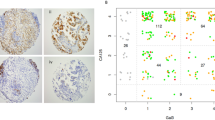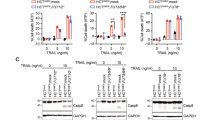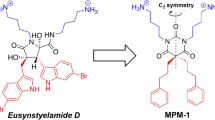Abstract
Galectins constitute a family of lectins that specifically exhibit the affinity for β-galactosides and modulate various biological events. Galectin-9 is a tandem-repeat type galectin with two carbohydrate recognition domains and has recently been shown to have an anti-proliferative effect on cancer cells. We investigated the effect of recombinant protease-resistant galectin-9 (hGal9) on multiple myeloma (MM). In vitro, hGal9 inhibited the cell proliferation of five myeloma cell lines examined, including a bortezomib-resistant subcell line, with IC50 between 75.1 and 280.0 nM, and this effect was mediated by the induction of apoptosis with the activation of caspase-8, -9, and -3. hGal9-activated Jun NH2-terminal kinase (JNK) and p38 MAPK signaling pathways followed by H2AX phosphorylation. Importantly, the inhibition of either JNK or p38 MAPK partly inhibited the anti-proliferative effect of hGal9, indicating the crucial role of these pathways in the anti-MM effect of hGal9. hGal9 also induced cell death in patient-derived myeloma cells, some with poor-risk factors, such as chromosomal deletion of 13q or translocation t(4;14)(p16;q32). Finally, hGal9 potently inhibited the growth of human myeloma cells xenografted in nude mice. These suggest that hGal9 is a new therapeutic target for MM that may overcome resistance to conventional chemotherapy.
This is a preview of subscription content, access via your institution
Access options
Subscribe to this journal
Receive 12 print issues and online access
$259.00 per year
only $21.58 per issue
Buy this article
- Purchase on Springer Link
- Instant access to full article PDF
Prices may be subject to local taxes which are calculated during checkout






Similar content being viewed by others
References
Barondes SH, Castronovo V, Cooper DN, Cummings RD, Drickamer K, Feizi T et al. Galectins: a family of animal beta-galactoside-binding lectins. Cell 1994; 76: 597–598.
Barondes SH, Cooper DN, Gitt MA, Leffler H . Galectins: structure and function of a large family of animal lectins. J Biol Chem 1994; 269: 20807–20810.
Brewer CF . Binding and cross-linking properties of galectins. Biochem Biophys Acta 2002; 1572: 255–262.
Wada J, Ota K, Kumar A, Wallner EI, Kanwar YS . Developmental regulation, expression, and apoptotic potential of galectin-9, a beta-galactosides binding lectin. J Clin Invest 1997; 99: 2452–2461.
Perillo NL, Marcus ME, Baum LG . Galectins: versatile modulators of cell adhesion, cell proliferation, and cell death. J Mol Med 1998; 76: 402–412.
Rabinovich GA . Galectins: an evolutionarily conserved family of animal lectins with multifunctional properties; a trip from the gene to clinical therapy. Cell Death Differ 1999; 6: 711–721.
Liu FT . Galectins: a new family of regulators of inflammation. Clin Immunol 2000; 97: 79–88.
Matsumoto R, Matsumoto H, Seki M, Hata M, Asano Y, Kanegasaki S et al. Human ecalectin, a variant of human galectin-9, is a novel eosinophil chemoattractant produced by T lymphocytes. J Biol Chem 1998; 273: 16976–16984.
Seki M, Oomizu S, Sakata K, Arikawa T, Watanabe K, Ito K et al. Galectin-9 suppresses the generation of Th17, promotes the induction of regulatory T cells, and regulates experimental autoimmune arthritis. Clin Immunol 2008; 127: 78–88.
Dai SY, Nakagawa R, Itoh A, Murakami H, Kashio Y, Abe H et al. Galectin-9 induces maturation of human monocyte-derived dendritic cells. J Immunol 2005; 175: 2974–2981.
Kageshita T, Kashio Y, Yamauchi A, Seki M, Abedin MJ, Nishi N et al. Possible role of galectin-9 in cell aggregation and apoptosis of human melanoma cell lines and its clinical significance. Int J Cancer 2002; 99: 809–816.
Lu LH, Nakagawa R, Kashio Y, Ito A, Shoji H, Nishi N et al. Characterization of galectin-9-induced death of Jurkat T cells. J Biochem 2007; 141: 157–172.
Okudaira T, Hirashima M, Ishikawa C, Makishi S, Tomita M, Matsuda T et al. A modified version of galectin-9 suppresses cell growth and induced apoptosis of human T-cell leukemia virus type I-infected T-cell lines. Int J Cancer 2007; 120: 2251–2261.
Makishi S, Okudaira T, Ishikawa C, Sawada S, Watanabe T, Hirashima M et al. A modified version of galectin-9 induces cell cycle arrest and apoptosis of Burkitt and Hodgkin lymphoma cells. Br J Haematol 2008; 142: 583–594.
Nobumoto A, Nagahara K, Oomizu S, Katoh S, Nishi N, Takeshita K et al. Galectin-9 suppresses tumor metastasis by blocking adhesion to endothelium and extracellular matrices. Glycobiology 2008; 18: 735–744.
Kiziltepe T, Hideshima T, Ishitsuka K, Ocio EM, Raje N, Catley L et al. JS-K, a GST-activated nitric oxide generator, induces DNA double-strand breaks, activates DNA damage response pathways, and induces apoptosis in vitro and in vivo in human multiple myeloma cells. Blood 2007; 110: 709–718.
Kuroda J, Kamitsuji Y, Kimura S, Ashihara E, Kawata E, Nakagawa Y et al. Anti-myeloma effect of homoharringtonine with concomitant targeting of the myeloma-promoting molecules, Mcl-1, XIAP, and beta-catenin. Int J Hematol 2008; 87: 507–515.
Nishi N, Itoh A, Fujiyama A, Yoshida N, Araya S, Hirashima M et al. Development of highly stable galectins: truncation of the linker peptide confers protease-resistance on tandem-repeat type galectins. FEBS Lett 2005; 579: 2058–2064.
Kuroda J, Kimura S, Segawa H, Sato K, Matsumoto S, Nogawa M et al. p53-independent anti-tumor effects of the nitrogen-containing bisphosphonate zoledronic acid. Cancer Sci 2004; 95: 186–192.
Kuroda J, Puthalakath H, Cragg MS, Kelly PN, Bouillet P, Huang DCS et al. Bim and Bad mediate imatinib-induced killing of Bcr/Abl+ leukemic cells and resistance due to their loss is overcome by a BH3 Mimetic. Proc Natl Acad Sci USA 2006; 103: 14907–14912.
Lu C, Zhu F, Cho YY, Tang F, Zykova T, Ma WY et al. Cell apoptosis: requirement of H2AX in DNA ladder formation, but not for the activation of caspase-3. Mol Cell 2006; 23: 121–132.
Sluss HK, Davis RJ . H2AX is a target of the JNK signaling pathway that is required for apoptotic DNA fragmentation. Mol Cell 2006; 23: 152–153.
Lu C, Shi Y, Wang Z, Song Z, Zhu M, Cai Q et al. Serum starvation induces H2AX phosphorylation to regulate apoptosis via p38 MAPK pathway. FEBS Lett 2008; 582: 2703–2708.
Xu F, Sharma S, Gardner A, Tu Y, Raitano A, Sawyers C et al. Interleukin-6-induced inhibition of multiple myeloma cell apoptosis: support for the hypothesis that protection is mediated via inhibition of the JNK/SAPK pathway. Blood 1998; 92: 241–251.
Hideshima T, Mitshiades C, Akiyama M, Hayashi T, Chauhan D, Richardson P et al. Molecular mechanisms mediating antimyeloma activity of proteasome inhibitor PS-341. Blood 2003; 101: 1530–1534.
Anderson KC . Lenalidmide and thalidomide: mechanisms of action—similarities and differences. Semin Hematol 2005; 42: S3–S8.
Chauhan D, Anderson KC . Mechanism of cell death and survival in multiple myeloma (MM): therapeutic implications. Apoptosis 2003; 8: 337–343.
Hideshima T, Catley L, Yasui H, Ishitsuka K, Raje N, Mitsiades C et al. Perifosine, an oral bioactive novel alkylphospholipid, inhibits Akt and induces in vitro and in vivo cytotoxicity in human multiple myeloma cells. Blood 2006; 107: 4053–4062.
Carew JS, Nawrocki ST, Reddy VK, Bush D, Rehg JE, Goodwin A et al. The novel polyamine analogue CGC11093 enhances the antimyeloma activity of bortezomib. Cancer Res 2008; 68: 4783–4790.
Hideshima T, Akiyama M, Hayashi T, Richardson P, Schlossman R, Chauhan D et al. Targeting p38 MAPK inhibits multiple myeloma cell growth in the bone marrow milieu. Blood 2003; 101: 703–705.
Mitsiades CS, Ocio EM, Pandiella A, Maiso P, Gajate C, Garayoa M et al. Aplidin, a marine organism-derived compound with potent antimyeloma activity in vitro and in vivo. Cancer Res 2008; 68: 5216–5225.
Feng R, Oton A, Mapara MY, Anderson G, Belani C, Lentzsch S . The histone deacetylase inhibitor, PXD101, potentiates bortezomib-induced anti-multiple myeloma effect by induction of oxidative stress and DNA damage. Br J Haematol 2007; 139: 385–397.
Shimizu T, Nakazato T, Xian MJ, Sagawa M, Ikeda Y, Kizaki M . Resveratol induces apoptosis of human malignant B cells by activation of caspase-3 and p38 MAP kinase pathways. Biochem Pharmacol 2006; 71: 742–750.
Kashio Y, Nakamura K, Abedin MJ, Seki M, Nishi N, Yoshida N et al. Galectin-9 induces apoptosis through the calsium-calpain-caspase-1 pathway. J Immunol 2003; 170: 3631–3636.
Jimbo A, Fujita E, Kouroku Y, Ohnishi J, Inohara N, Kuida K et al. ER stress induces caspase-8 activation, stimulating cytochrome c release and caspase-9 activation. Exp Cell Res 2003; 283: 156–166.
Acknowledgements
This work was partly supported by Grants-in-Aid for Scientific Research from the Ministry of Education, Culture, Sports, Science, and Technology of Japan, and by grants from the Kobayashi Foundation of Innovative Cancer Chemotherapy, the Award in Aki's Memory from International Myeloma Foundation, and the Japan Leukaemia Research Fund (MT and JK).
Author information
Authors and Affiliations
Corresponding author
Ethics declarations
Competing interests
The authors declare no conflict of interest.
Additional information
Supplementary Information accompanies the paper on the Leukemia website
Supplementary information
Rights and permissions
About this article
Cite this article
Kobayashi, T., Kuroda, J., Ashihara, E. et al. Galectin-9 exhibits anti-myeloma activity through JNK and p38 MAP kinase pathways. Leukemia 24, 843–850 (2010). https://doi.org/10.1038/leu.2010.25
Received:
Revised:
Accepted:
Published:
Issue Date:
DOI: https://doi.org/10.1038/leu.2010.25
Keywords
This article is cited by
-
Galectins and galectin-mediated autophagy regulation: new insights into targeted cancer therapy
Biomarker Research (2023)
-
Decoding the sweet regulation of apoptosis: the role of glycosylation and galectins in apoptotic signaling pathways
Cell Death & Differentiation (2019)
-
Integrative analysis of signaling pathways and diseases associated with the miR-106b/25 cluster and their function study in berberine-induced multiple myeloma cells
Functional & Integrative Genomics (2017)
-
Galectin-1 suppression delineates a new strategy to inhibit myeloma-induced angiogenesis and tumoral growth in vivo
Leukemia (2016)
-
Galectin-9: From cell biology to complex disease dynamics
Journal of Biosciences (2016)



